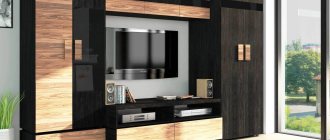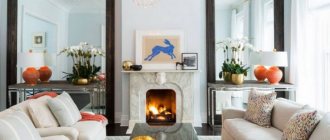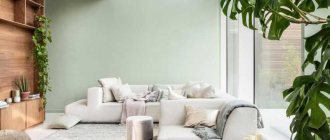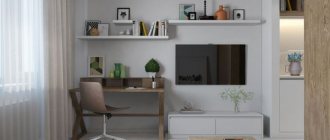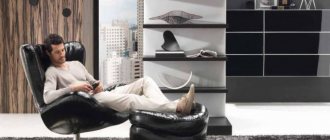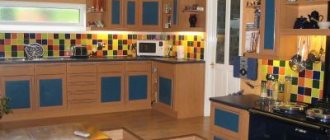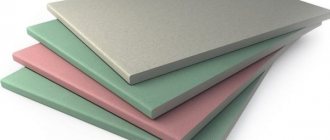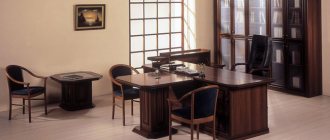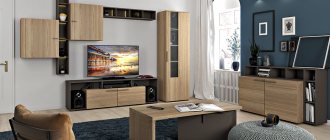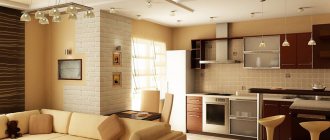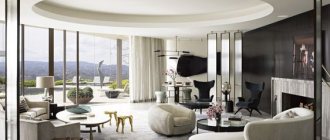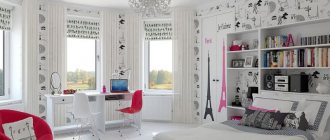Shelving in the living room is perhaps the most necessary, convenient and popular item in the interior.
Without them, a space of any style is unthinkable; they are much more effective at preserving the free area of the territory, while accommodating a considerable amount of things, while maintaining free access to them.
They can be used to equip any room, but a shelving unit in the living room is a fairly versatile piece of furniture and can easily suit completely different design styles.
Variety of designs for the living room
There are a huge number of types of racks:
A traditional classic version of shelves, which has many levels fixed on supports.
This type completely lacks not only doors, but also the walls of the side and rear parts. This very ordinary furniture is most often used in high-tech, minimalism, etc. styles.
A rack in the form of a furniture wall or cabinet has all three walls and part of this structure is closed with doors. When using this design, we must not forget about the free, spacious shelf for the TV.
Modern designers offer an original rack in the form of a cylinder, which, rotating around its axis, gives free access to any part.
If there is a free niche in the living room, then it is advantageous to place a built-in shelving unit, which does not occupy the room’s area at all, but can be installed in only one place
It is also appropriate to consider decorative hanging shelves, which are not entirely functional, but are aesthetically acceptable. Shelving with asymmetrical shapes brings a special charm to the interior, bringing originality and creativity to the interior.
Product benefits
Shelving system options for the living room have many advantages:
- the low weight of such furniture simplifies installation and significantly reduces the time it takes to furnish a room;
- a product of even the most complex shape remains mobile and can be easily moved to any other place;
- it is very easy to find any items on the open shelves of the rack;
- such designs are very practical. Shelves and compartments can be of different sizes, which allows you to increase the functionality of the product. For example, create a shelf for a TV in the living room;
- Open shelving for the living room makes ideal partitions. They delimit zones, but do not block the perspective of the room and do not visually reduce the living room area. In addition, the product remains functional: you can store any things on the shelves;
- racks are more economical than wall modules or full-fledged cabinets. Since racks are rarely equipped with doors, there is no need for space to open them, and the height of the structure allows you to place a large number of things;
- With the help of a shelving unit you can add personality to your living room.
The product also has some disadvantages:
- open shelves imply keeping things on them in ideal or at least relative order;
- Some items cannot be stored this way.
Materials for making a rack
Most often, wood, pressed wood chips and MDF are used for the production of shelving. These materials harmonize perfectly with any interior style.
A rack with shelves made of thick durable glass on metal or wooden supports looks advantageous in a modern room style.
For a simpler rustic style, a wooden or bamboo shelving unit is suitable.
There are products made of plastic, but they are less reliable and have limited capacity, so they serve the function of decorating the living room space.
Homemade shelving decor options
The shelving can be left unchanged after assembly, especially if solid wood is used. Such designs have a pleasant design with a natural shade (walnut, wenge, oak). However, craftsmen often additionally decorate finished structures in one of the following ways:
- Stencil painting using acrylic paints.
- The use of special PVC films that imitate various materials (stone, brickwork, gypsum panels).
On the facades you can hang beautiful souvenirs made by yourself (papier-mâché plates with original painting).
Shelf colors
The color of the shelving should be in harmony with the overall tone of the room and the style of the furniture.
As an example: a white (milky or beige) shelf contrasts perfectly with the bright rich color of the walls of the room, giving it lightness and an elegant frame.
Classic design: white walls and black shelving. This position will most advantageously emphasize the strict lines of the living room furniture.
If the walls of the room have warm, calm tones, then a bright, catchy shelving unit will be beneficial to focus attention on itself, giving a special zest to the room.
Varieties of racks by shape and size
There are several types of racks:
- Frame - lightweight structures consisting of several shelves fastened with racks.
- In the form of a wall - multi-tiered shelves, with a back wall and closing doors, can also be divided into cells. There are shelves with a special place for a TV.
Shelving dimensions:
- Width – typical size is 90 cm, the wall can be 2-3 m wide.
- Height - 1.8 m, but there are others.
- The depth of the shelves is 45 cm, the lower ones can be up to 30 cm deep.
- The distance between shelves is from 35 to 40 cm.
In addition, racks can be divided into classes:
- Built-in. Attached to the walls of niches. Due to their compactness and ergonomics, they are often used in kitchens and office spaces.
- Standard straight. They look like regular cabinets, but without front doors.
- Angular. Compared to straight ones, they have more usable area and are suitable in cases where you need to place a lot of things.
- Hanging. Lightweight designs with intricate shapes.
Racks can have both symmetrical and asymmetrical shelves in a variety of configurations: rectangular, square, straight, curved and even zigzag.
Stepped type shelving is a rather unusual choice; such models consist of several modules that are installed in ascending order in the form of a ladder.
Such designs are usually open, do not have a back wall and can fit into any modern room design.
Narrow horizontal and vertical designs are very popular. They save a lot of space and look minimalistic.
U-shaped models are very roomy and compact. They are used to frame doorways, sofas, beds and other furniture elements.
Correct installation of shelves in the living room
A modern compact shelving unit has advantageously replaced huge walls and cabinets. A shelving unit for a room is usually a multifunctional structure that accommodates: a bookcase, shelves for decorations (figurines, photo frames, etc.), space for a TV, cinema, video equipment and audio system.
A small narrow shelf will comfortably place books, magazines, newspapers and other everyday items.
The dining area in the living room will fit perfectly with a rack for beautiful dishes, cutlery and similar accessories.
This convenient design will also come in handy in the work area, where books, disks and work tools (pens, rulers, notebooks) will be placed.
In the sitting area of the living room, a small shelf filled with books can serve as a personal home library. And in the niche under the last shelves, located quite high, a sofa or armchair will fit comfortably.
It is very convenient to use a shelving unit in the form of a partition that separates one area of the living room from another area. If you make it high and deaf (close the back wall), then each zone will become an almost isolated individual room.
And a small structure, playing the role of a partition without walls, will be, as it were, part of the living room layout.
Racks on wheels are gaining popularity; by moving them, you can periodically change the geometry of the space.
The shelves are filled strictly individually, at the discretion of the owner of the room, adhering to his preferences and tastes!
DIY shelving: diagrams and drawings
The principle of making a rack with your own hands depends on the chosen design.
The simplest options are stationary and collapsible blocks with shelves. This is a structure of transverse supports and vertical posts.
In one case it is strengthened and immovable, in the other it suggests the possibility of easy changes to the design. The transformation occurs mainly due to the ability to change the level of the shelves. This is achieved by using perforated metal for the base.
Mobile and rotating racks offer expanded functionality, but not everyone can make them themselves. To decide on the design, you need to clearly understand the purpose of the item and take into account the dimensions of the room.
In any case, work begins with choosing the type of rack. This will be followed by drawing up a drawing. Even if this is a simple option, a diagram marking the parameters of the future product will be required to complete the work.
Each component of the item is assessed in detail and included in the drawing. Having completed a schematic representation, it becomes possible to evaluate the upcoming result and make the necessary adjustments in time.
The next stage of work will be the purchase of materials and preparation of tools. Everyone here has their own strategy.
Having gone through all the preparatory steps, they proceed directly to production. First you need to prepare all the details. The blanks are made according to the scheme and previously specified parameters.
After this, the frame is assembled, which is subsequently supplemented with shelves. They act strictly according to the planned scheme. In this case, the likelihood of needing alterations is minimal.
Photo of shelving in the living room interior
Where to place the rack
At the door
Narrow vertical shelving is suitable for framing doorways, or you can fill the entire space around the door with shelving.
Around the TV
Many racks that are placed along the entire wall provide space for a TV.
The storage system can be combined, that is, with open and closed shelves.
Under the stairs
The shelving under the stairs can be placed half or one third deep. Shelves can also be installed on the side or back of the stairs.
As a rule, the width between them is the same and the shelves are usually attached after 1 or 2 steps.
If desired, you can make a storage system of either a closed or open type.
In the space between the windows
The space between the windows can be made into additional storage space and filled with shelving.
You can place small vertical or horizontal structures between the windows.
Thanks to the presence of shelving, you can lengthen the window sill, creating an atmospheric and impressive look.
How to decorate open shelving shelves
Place books in boxes and baskets
One way to decorate a book shelf is to arrange them in low baskets and boxes. For example, sort them by author name or subject. This will make it easier to remove the book from the shelf, including in order to wipe off the dust.
Using this technique, experiment with the arrangement of volumes: covers up, or spines forward.
Design: LiLu Interiors
Tip: cardboard folders can be used to store two- and three-volume books; this will help in the visual organization of books and make the appearance of the shelving more impressive.
Leave some shelves empty
Sometimes you need to be inspired by emptiness to make the interior more interesting. This technique also works with open shelving decor. Leave some free space, this will add air and dynamics to the interior. In addition, empty shelves will help separate already arranged accessories from each other.
If you don't have a lot of storage space and leaving empty space seems like a luxury, combine open and closed shelves with doors and drawers. For example, for IKEA shelving, you can purchase removable doors and drawer inserts.
Photo: IKEA
Place objects symmetrically to each other
One of the effective and simple ways to make a shelving unit stylish is to use the “mirror principle”, when the right side of the cabinet is symmetrical to the left. To do this, arrange items that are identical or as similar as possible to each other in color and shape on two single-level shelves. Paired vases, baskets, boxes or candles will help with this.
Design: Sabal Homes
Hide the spines of the books
The “not for everyone” option is to hide the spines of the books back against the wall of the shelf. It looks impressive and will certainly add zest to the room, and will also help create a monochrome interior.
Why is the option “not for everyone”? Firstly, this solution is not suitable for people with dust allergies. It is much easier to wipe the spines of books. Secondly, if you are an avid book reader, it will be inconvenient to choose the next book, taking one by one from the shelf to see the title.
Design: Creation
Who might like it? Owners of large libraries who do not want to throw away ancient volumes, but also will definitely not read all the collections in the near future. We also recommend trying this technique for those who like experiments.
Create a design in several rows
One of the simple and working design techniques is to arrange objects in several rows. For example, on stacks of books there are small figurines or candles in candlesticks. This method makes small accessories more significant and noticeable.
Photo: IKEA
Use the front of the rack to decorate
We're used to framed photographs and small paintings being placed on shelves, but we rarely see anyone hanging them on the front of a shelving unit. In this case, the shelves behind the painting or poster can be left empty or you can put not very aesthetic, but useful things. If you choose the second option, make sure that the objects covered by the picture can be easily reached.
Design: Paces Construction Co
Arrange books by color
Arranging books by spine color rather than alphabetically is a way to make your home library stand out. The technique is suitable not only for owners of a large number of books: you can simply fill one shelf with colored collected works, and the second with black and white.
Tip: you can not only put books, but also stack them on top of each other.
Design: Kropat Interior Design
Avoid items that are too small
Very small items will most likely not add beauty to your shelving, but rather create visual clutter. Large objects will help hide mismatched book spines and chaos on the shelves, attracting the eye.
Design: Jonathan Raith
Make beautiful installations with your own hands
If you're a fan of small accessories, like bringing back seashells from vacation or growing succulents, create beautiful arrangements with them. Place shells in glass vases or aquariums, and small plants in candlesticks or decorative lanterns.
Photo: urbanoutfitters.com
